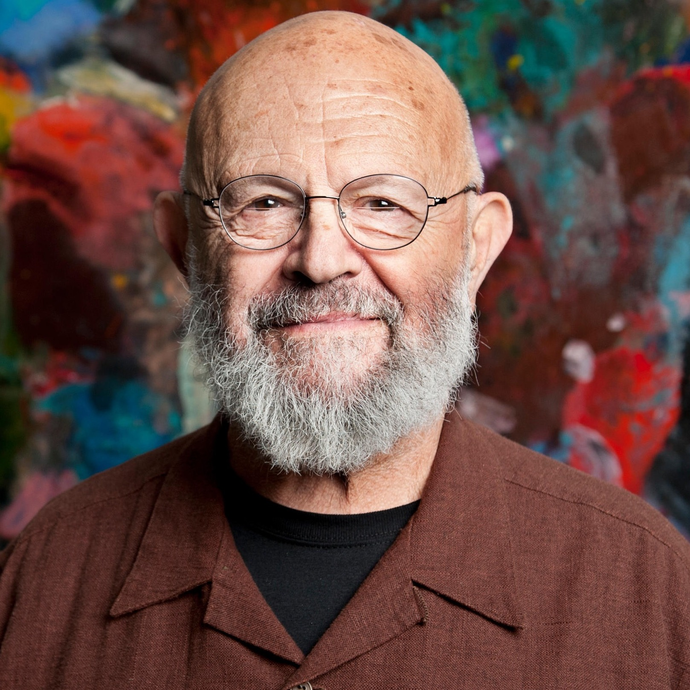
Jim Dine
Jim Dine is an American artist known for his diverse and prolific body of work. His artistic repertoire includes painting, drawing, and printmaking in various forms, as well as sculpture and photography. Dine's early works featured assemblages and happenings. In recent years, he has expanded his creative expression to include poetry.
Biography of Jim Dine
Jim Dine was born in 1935 in Cincinnati, Ohio, USA. During his senior year of high school, he studied at night at the Cincinnati Art Academy. He then attended the University of Cincinnati, the School of the Museum of Fine Arts, Boston, and Ohio University, where he earned his B.F.A. in 1957.
After his studies, Dine moved to New York where he began teaching at the Rhodes School. He soon became a pioneering creator of 'Happenings,' collaborating with Allan Kaprow, Claes Oldenburg, and Robert Whitman.
Dine's first exhibition took place at the Reuben Gallery, where he also presented the elaborate performance "Car Crash" (1960).
Since the early 1960s, Dine has refined a selection of motifs to explore his self in various forms and media, across the different locations and studios where he has worked. His motifs include bathrobes, hearts, Pinocchio, antique sculptures, and tools.
Since his debut solo exhibition in New York in 1960, Jim Dine's paintings, sculptures, photography, and prints have been featured in more than 300 solo exhibitions worldwide. Recent shows include "Jim Dine; Dog on the Forge" at Palazzo Rocca in Venice by Kunsthaus Goettingen for the 60th Venice Biennale (2024), "Jim Dine: Last Year’s Forgotten Harvest" at Bowdoin College Museum of Art (2023), "Jim Dine: Three Ships" at Templon Gallery in Paris (2023), and many more.
In 2013, the German publisher Steidl released "A Printmaker's Document" by Jim Dine, documenting his 50-year printmaking career. The following year, in 2014, Dine donated over 200 prints, including single sheets, portfolios, and illustrated books spanning fifty-five years, to the British Museum in London, in tribute to Alan Cristea.
Currently, the artist lives and works in Walla Walla, Washington and Paris.
Jim Dine's Art Style
Dine has been linked with several art movements such as Neo-Dada, Abstract Expressionism, and Pop Art, yet he has consistently resisted classification. Central to his art, irrespective of the medium, is a profound autobiographical introspection—an unyielding exploration and critique of self.
His work revolves around personal motifs including the heart, the bathrobe, tools, antique sculpture, and the character of Pinocchio, alongside elements like flora, skulls, birds, and figurative self-portraits.
In 1964, Dine first began depicting bathrobes as part of his exploration of new forms of self-portraiture, a departure from traditional representations of the face during a period when making a self-portrait wasn't considered cool.
Another motif, the heart, has been embraced by Dine due to its formal simplicity, allowing him to wholly appropriate it as his own. It serves as an empty canvas for ongoing experimentation, reflecting his evolving self. As a universal symbol of love, the heart also mirrors Dine's deep commitment to the creative process.
Dine's fascination with the character of Pinocchio began in childhood when, at the age of six, he watched Walt Disney's animated film with his mother. His interest deepened in 1964 when he encountered a detailed figure of Pinocchio. However, it wasn't until the 1990s that Dine started depicting this character in his art. Subsequent representations of Pinocchio appeared at the 1997 Venice Biennale and an exhibition at Richard Gray Gallery in Chicago. In recent years, Dine's identification with the character of Pinocchio has shifted towards Geppetto, the skilled woodcarver who creates the puppet boy.
Just as with Pinocchio, Dine's interest in antique sculpture traces back to his early life. He often channels this fascination through depictions of the Venus de Milo. Additionally, Dine draws inspiration from renowned sculpture collections such as the Glyptothek in Munich.
Years:
Born in 1935
Country:
United States of America, Cincinnati, Ohio